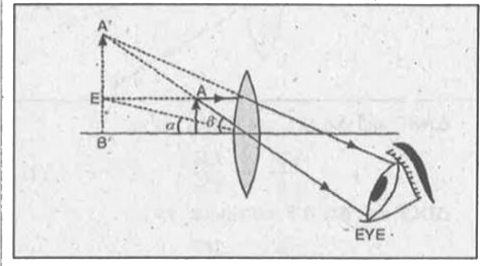Draw the ray diagram for simple microscope. Write expression for its magnifying power.
Microscope. Microscope is a device which is used to see very small objects which cannot be seen with naked eye.
Simple Microscope
Principle. When an object is placed between principal focus and optical centre of a convex lens, a vertical and erect image will be formed on the same side of the object.
Construction and Action
An ordinary convex lens of small focal length held close to the eye can be used as magnifying glass or a simple microscope. The object is made to lie between the lens and its focus so that image formed is virtual, erect and magnified. As the object is to be seen clearly, the image is made to lie at the distance of distinct vision from the eye. The course of rays indicating the formation of image is shown in the figure.

Magnifying Power Magnifying Power of a magnifying glass is defined as the ratio of the angle subtended at the eye by the image to the angle subtended by the object when both are placed at the least distance of distinct vision and seen directly.
In Fig., the image AB is fomed at the distance of distinct vision and subtends an ∠A.CB.=β on the eye as it is held close to the lens. If the object AB is also moved to the distance of distinct vision i.e., to the position EB., it would subtend an ∠ECB.=α at the eye.
Magnifying power, M=βα
=tanβtanα
(∴β and α are small)
=ABCBEB.CB.
=ABCB×CB.EB.
=CB.CB (∴ AB = EB.)
M=vu
Using the lens formula,
1v−1u=1f
∴1u=1v−1f
or vu=vv−vf
or vu=1−vf
Since image is formed at least distance of distinct vision D and is virtual,
∴ v = - D
So M=1−−Df
or M=1+Df
This shows that smaller the focal length of the lens, greater will be the magnifying power of microscope.
Topper's Solved these Questions
- OPTICSBOOK - MBD -HARYANA BOARDCHAPTER - OPTICSEXERCISE - OBJECTIVE TYPE QUESTIONS
26 Videos
- OPTICSBOOK - MBD -HARYANA BOARDCHAPTER - OPTICSEXERCISE - SHORT ANSWER TYPE QUESTIONS
46 Videos
- MODEL TEST PAPER - 2BOOK - MBD -HARYANA BOARDCHAPTER - MODEL TEST PAPER - 2EXERCISE - SET - D ( LONG ANSWER TYPE QUESTIONS)
4 Videos
- PRINCIPLES OF COMMUNICATIONBOOK - MBD -HARYANA BOARDCHAPTER - PRINCIPLES OF COMMUNICATIONEXERCISE - Objective Type Questions
19 Videos
Similar Questions
Knowledge Check
The magnifying power of simple microscope is
Adirectly proportional to its focal length .Bdirectly proportional to object distnace.Cinversely proportional to square of its focal length.Dinversely proportional to its length
Draw course of rays through a compound microscope. Deduce an expression for its magnifying power. How can the magnifying power be increased ?
View Solution(a) Draw a ray diagram for final image formed at distance of distinct vision (D) by a compound microscope and write expression for its magnifying power.
(b)An angular magnification (magnifying power) of 30x is desired for a compound microscope using as objective of focal length 1.25cm and eye piece of focal length 5cm. How will you set up the compound microscope?
View Solution(a) Draw a ray diagram for final image formed at distance of distinct vision (D) by a comppound microscope and write expression for its magnifying power.
(b) An angular magnification (magnifying power) of 30x is desired for a compound microscope using as objective of focal length 1.25 cm and eye piece of focal length 5 cm. How will you set up the compound microscope?
View SolutionWith the help of a ray diagram, explain the formation of image in an astronomical telescope for a distant object. Define the term magnifying power of a telescope. Derive an expression for its magnifying power when the final image is formed at the least distance of distinct vision.
View SolutionDraw a labelled ray diagram of an astronomical telescope in the near point position. Write the expression for its magnifying power.
View SolutionDraw a labelled ray diagram of an astronomical telescope in the near point position. Write the expression for its magnifying power.
View SolutionDraw a labelled ray diagram to show the image formation in an astronomical telescope for normal adjustment position. Write down the expression for its magnifying power.
View Solution
